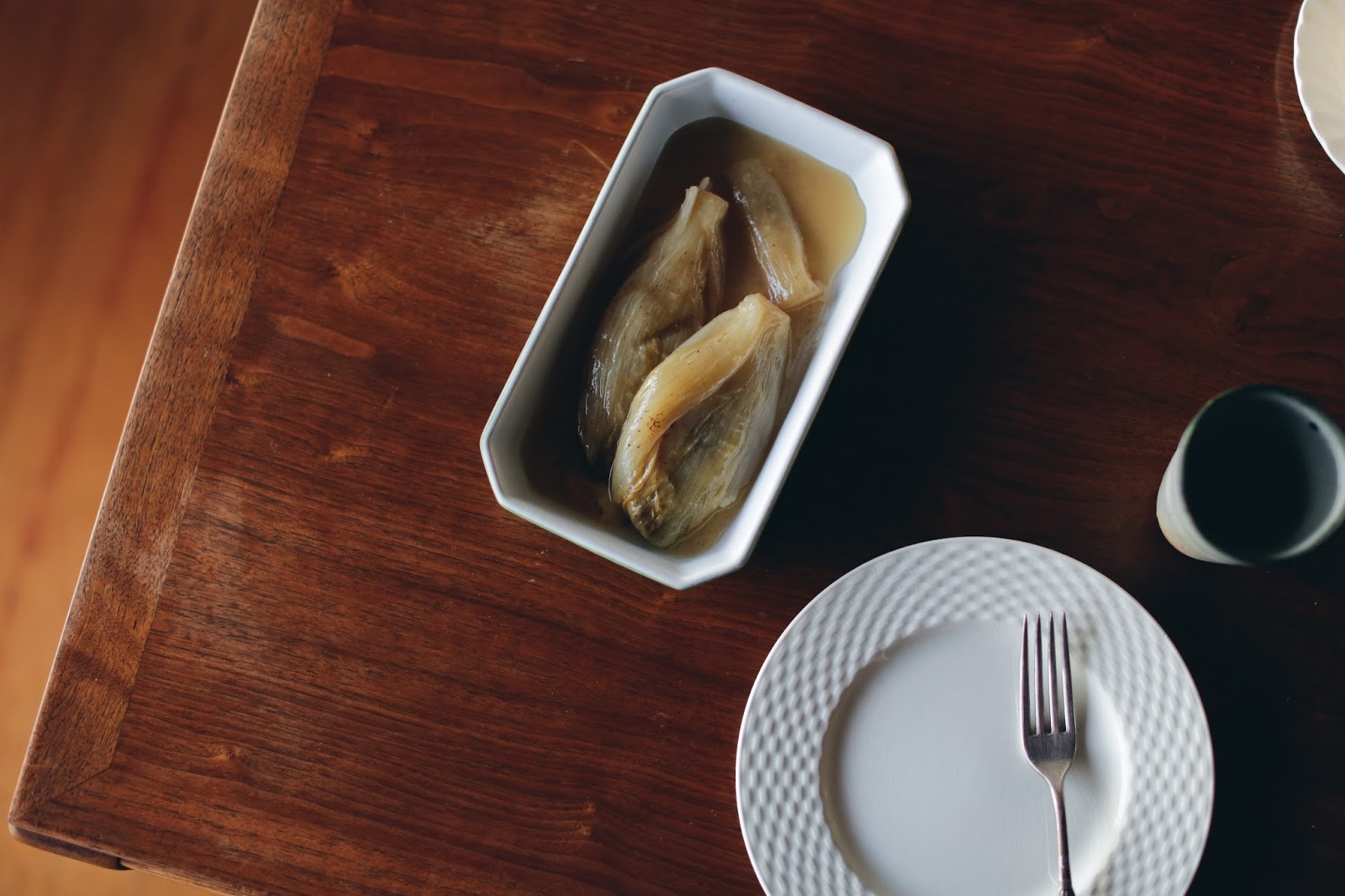Month: November 2014
Like he did
The three of us have that hanger-onner of a virus that’s going around. The past two nights, I’ve coughed myself to sleep in the basement guest room, and as anyone who’s ever coughed herself to sleep can tell you, it’s slow going. I use the time to think about pressing issues like how much I like the taste of original Ricola, or how it could be that Alice’s feet smell so exactly like buttered popcorn, or how much I prefer haunted, unsmiling, True Detective-era Matthew McConaughey over other Matthew McConaugheys, even with the long hair that makes him a ringer for my uncle. Or, if I’m really on my game, I use the time to write in my head. Two nights ago, for instance, I found myself thought-writing about endive: about how much I hated it as a kid, about how much my dad loved it, about how he was always buying it and shoving it into salads when I wasn’t looking, about how fast he would have jumped to get himself around our dinner that night: bread, cheese, and Jennifer McLagan’s Belgian Endive Bathed in Butter.
In a couple of weeks, on December 7th, it will have been twelve years since my dad died. He’s now been gone for a third of my life. I’m glad to be able to say that, at this point, I don’t think about him a lot, and that I remember only faint outlines of what it felt like to grieve him. It feels like progress. But there must be some subterranean part of me that doesn’t forget, because every late November or early December, sometimes even on the 7th itself, he shows up. Maybe I notice the picture of him in the front hall for the first time in months, or I read a book to June and suddenly hear him thirty years back, reading it to me. Brandon blows his nose in the next room over, and because his nose has started to honk like a migrating goose, like my dad’s did, I forget for an instant who is on the other side of the wall. Or maybe I eat endive for dinner and then lie there in the dark, paging through one of the photo albums I keep in my head. My mother tells me that the same thing happens to her. We call and swap pictures.
I remember worrying as a kid, when I heard that someone I knew had died, that they might come back to haunt me, that maybe they would have something important to say and would choose me as the person to tell. From the bathroom of the house I lived in as a kid, I could look into the mirror above the sink and see behind me into the living room, and I was sure that, looking up sometime from spitting out my toothpaste, I’d see a ghost there. I consoled myself by eventually deciding that, if the dead person in question really cared about me, they’d have the courtesy, at least, to find a way to come back that wouldn’t scare the crap out of me. They’d be subtle about it. Anyway, I didn’t need to worry: nothing so Unsolved Mysteries has ever happened to me. But I still think about it sometimes, especially at this time of year. My dad has his ways.
I spent a lot of time worrying about those ways, really. He loved cheese and butter and paté and meat, everything that was bad for you in the ’80s and ’90s. He had a substantial gut. It was irresponsible! Of course, none of that is what did him in: as it turned out, behind his gut was a tumor the size of a half-gallon jug of milk, and kidney cancer doesn’t care what you eat. Still, it would take some years before I would think to, or dare to, bake eight endives in almost a stick of butter, and before I could appreciate butter in any way like he did.
Well! At this point in the post, I guess I should state very clearly, and unsexily, that I received Jennifer McLagan’s Bitter: A Taste of the World’s Most Dangerous Flavor, with Recipesfrom its publisher, as a free, unsolicited review copy. And that I loved it immediately, not only because I like bitter flavors – Brussels sprouts, Campari – but also because, as my friend Brandi puts it, Jennifer McLagan “really goes there” in everything she does. Her books celebrate some of the most basic elements of food – and in particular, the elements that no one likes to talk about, like fat and offal. Bitter is her latest, out only two months now, and the recipe for Belgian Endive Bathed in Butter was the first I dog-eared.
I conquered my aversion to endive a long time ago, but even if that weren’t the case, I think it would be hard to find this endive less than lovable. It starts with butter browning in a skillet, to which you add whole endives, turning them to coat, and then lemon juice, and then you cover the whole thing, slide it into a low oven, and two hours (two hours!) later, you open the oven triumphantly to find the endives caramelized, as soft and floppy as wet rags – tasty wet rags, reeeeally tasty wet rags – in a brothy sauce of their own juices, enriched and mellowed with butter, brightened with citrus. You could serve them next to a pork chop or a piece of roasted chicken, but we ate them on a tired, coughing Thursday night, with just bread and an aged goat cheese that I had picked up earlier in the day. And then we slept, or rather didn’t sleep for a while, and then sleep came, and then morning came, and then there were leftovers.
P.S. Because of you, Delancey has made it to the final round of the Goodreads Choice Awards. If you would, please consider casting a vote again. Thank you.
Belgian Endive Bathed in Butter
From Bitter: A Taste of the World’s Most Dangerous Flavor, with Recipes, by Jennifer McLagan
As McLagan explains, endive should never be cooked in water, because it’s mostly water itself; instead, what it needs is fat. I advise you to listen to her, and to have some good bread or hot rice on hand, to soak up the pan juices.
One additional note: the original recipe calls for three tablespoons of lemon juice, but I found it a little too lemony. I may well be nuts. But I would suggest starting with two tablespoons and adding more as needed.
Preheat the oven to 300°F.
Wipe the endives with a damp cloth, tear away any leaves that have gone bad, and trim the stem end, if needed.
Choose an ovenproof skillet with a lid (or, if you don’t have a lid, aluminum foil will work), one that’s just large enough to hold the endives in a single layer. Place the skillet over low heat, and add the butter. When the butter is melted, raise the heat to medium, and cook the butter, stirring and scraping the bottom of the pan from time to time, until the milk solids begin to brown and the butter smells nutty. Add the endives – yes, you’re using them whole, not sliced or halved or otherwise cut up – and lower the heat. Turn them to coat with butter, and season them with salt. Cook, turning occasionally, until they are lightly colored, then pour in 2 tablespoons of the lemon juice. Cover the pan, and place it in the oven for 1 hour. Remove the pan from the oven, turn the endives carefully, and then cover it again and return it to the oven. Cook for another 45 minutes to 1 hour, or until the endives are limp and very, very soft.
Before serving, taste a little of the pan juices, and if you’d like more brightness, add lemon to taste. Serve hot, with more salt at the table and freshly ground pepper.
Yield: 4 servings
I got to go back

The first time I went to the Oklahoma Arts Institute at Quartz Mountain was in the summer of 1995, a few months after a fire destroyed the lodge, its rooms and dining hall and library. I was sixteen, one of about a dozen high school students from across the state who’d been accepted to the summer program in poetry. Quartz Mountain is beautiful, an isolated chain of red crags along a lake in the southwest part of the state, but my introduction wasn’t poetic: because the library was gone, our class met in a trailer, with a limping air conditioner, folding tables, and a couple of electric typewriters that we shared. But our teacher was the poet Peter Fortunato, brought…
Read more

